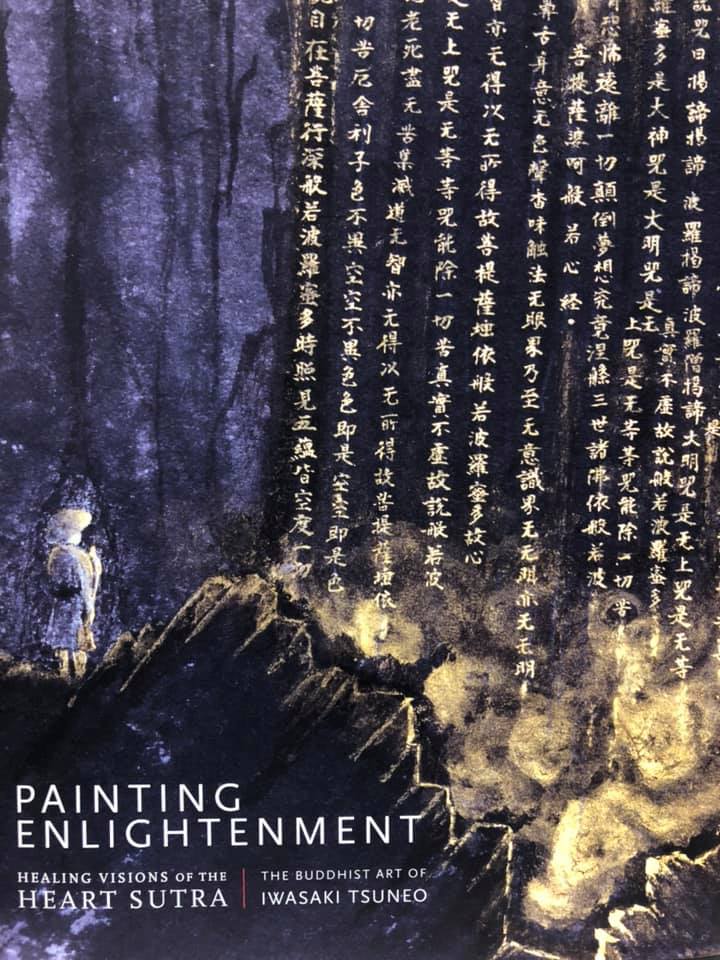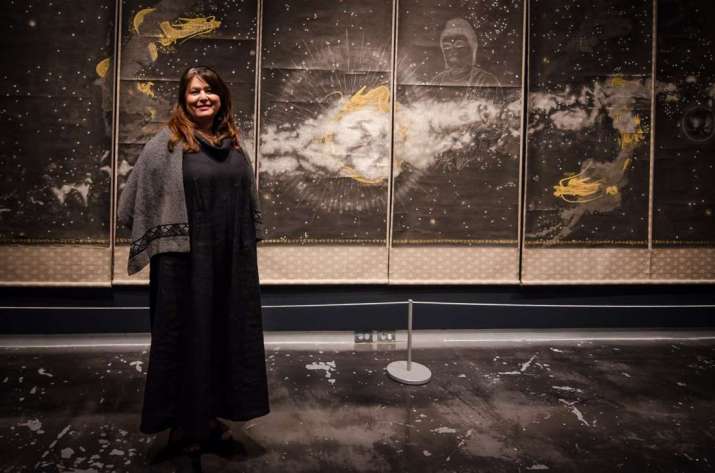Gazing, the seeker contemplates,
“Where am I?”
Home. (140)
The Heart Sutra, an immensely important Buddhist scripture in East Asia, has been a fount of spiritual inspiration and artistic creativity since the beginning of the Common Era. It was copied and circulated tirelessly, and in a few centuries poetry, art, and different liturgical interpretations of the sutra were generated across the entire continent, from China to Japan to Indonesia. The Heart Sutra has informed the poetic, aesthetic, literary, and artistic sensibilities of Japanese Buddhists since it was first introduced to Japan during China’s Tang dynasty (618–907). Often seen as the most beloved Buddhist scripture in Japan, the Heart Sutra has inspired a series of stunning, visionary art by Iwasaki Tsueno (1917–2002), who is the subject of Paula Arai’s visually captivating and eloquent book Painting Enlightenment: Healing Visions of the Heart Sutra. (Shambhala 2019)
The book is divided into several sections with beautifully titled chapters.* The first part, “Iwasaki: Scientist and Healing Visionary,” is a tribute to Iwasaki, from his wartime experience and love of science to his artistic techniques. The second section, “Seeing the Wisdom of Compassion,” introduces more than 50 pieces of his work. The final section, “Healing Art, Healing Heart,” rounds off the book with a reflection on the lessons for our own difficult times:
. . . we have attuned to the activity of solar prominences, planetary motion, waterfalls, star nurseries, blossoming flowers, and the stirrings of healing hearts. . . . We have intimated experienced the interdependent flow of the universe. . . . Connecting and flowing, we feel the pulse of the cosmos and hear the peal of compassion. (160)
Iwasaki presented an understanding of Buddhism as a tradition of three streams: science, spirituality, and art. He was not particularly well known during his lifetime, although he was a reasonably accomplished scientist, having researched silkworms and published prolifically while maintaining a day job as a high school teacher. Arai writes:
. . . Iwasaki merges the three streams of Buddhist spirituality, science, and art, generating a powerful current that carries the imagination into new and vibrant waters. . . . An explicit characteristic of Iwasaki’s art is that it accentuates the role the senses play in perceiving different dimensions of reality. Imagery and science are fundamentally reliant on sensory experience, but Buddhist teachings caution that our senses, if untrained in wisdom, can misinform us, leading to delusions that result in suffering. (9–10)
Crucial to appreciating Iwasaki’s art is the understanding in Japanese Buddhist culture of:
. . . beauty in forms as a path out of suffering. . . . He equates ultimate truth with phenomenal reality. In poetic terms, each dewdrop on a blade of grass teaches impermanence. Each time you hear a bird sing, you hear instructions on nondual wisdom. Spring rain turning into summer blossoms is a master class on the interdependent nature of reality. (10)

No review of this book is complete without highlighting some of the artistic masterpieces of Iwasaki. Lightning (84 x 61 cm) is a striking rendering of a spectacular lightning strike in the characters of the Heart Sutra, with a contemplative figure overlooking the lights of the city (53–54). Starry Sky (44 x 43 cm) follows a similar principle (99), as do many other beautiful works. One of my favorites is Pilgrimage to a Pagoda, a 220 x 140 cm scroll that creates a pagoda with 30 rounds of the Heart Sutra: 8,280 characters in total. A geometrically harmonious masterpiece, the Kannon bosatsu figure housed within this intricate pagoda is as outstanding as the structure housing it and the scenic mountain background. (67–69) The most spectacular piece among Arai’s list is what she calls Iwasaki’s magnum opus: Big Bang: E = MC2, (500 x 180 cm) which:
. . . illustrates the cosmic activity of transformation with the dynamic energy and forces at work in the Heart Sutra. Impermanence on a galactic scale shimmers across the seventeen-foot span that traverses six scrolls. (133)
There are several major components to this work:
1. The tiny dots of gold and silver that orbit our galaxy are globular star clusters, living fossils from the dawn of our universe. Our nearest neighbor, the similarly spiraling Andromeda galaxy, is in the upper right corner in a swirling round of Heart Sutra energy. (133–34)
2. . . . a gossamer Buddha of Infinite Light, Amida. By summoning this luminous Buddha, Iwasaki invokes the power of wisdom and compassion available in our cosmos. He avouches our cosmos is a Pure Land, a womb that embraces with compassion and nourishes with wisdom. (134)
3. Golden dragons that: wield adamantine wisdom, surging through space with the energy of emptiness, the source of all forms.
These dragons consist of:
– The mother dragon on the right is incubating six star eggs in the North American Nebula. (134)
– The dragon on the left protects the eight star eggs in the Eagle Nebula that features the ‘Pillars of Creation,’ the tallest pillar stretching four light-years high. (134)
– A third dragon swirls maternally around a supermassive black hole that spins at the heart of our galaxy, which is a spiraling activity of gravitationally bound forms. . . . To infuse the black hole with visual vigor, Iwasaki painted an eight-headed dragon to writhe at its center.” Visually, two copies of the Heart Sutra are being sucked into the black hole, their characters a churning eddy of interstellar enlightenment. Iwasaki’s interpretation of the black hole, the most mysterious objects of our universe, is truly sublime: “That which falls beyond the event horizon of the black hole extinguishes the flame of suffering . . . Black holes are bodhisattvas in astrophysical form that transform suffering into compassion. (137–38)
4. A contemplative figure stands on a mountain range in the lower left corner, reflecting how we, too, can function like black holes. (139)

Big Bang: E = MC2 is one of the most imaginative Buddhist-themed artistic works to have been created in the 20th century, although admirers of Iwasaki’s works will surely have diverse views about their favorites.
This is a truly unique book, which will delight diverse interest groups: from aficionados of art, particularly Asian or Japanese art, to practicing Buddhists and spiritual seekers (thanks to Arai’s eloquent, inspiring commentary and recollections of Iwasaki’s life and thinking). Iwasaki’s art is at its most vibrant and attractive in this volume. Painting Enlightenment is a superb tribute to a self-taught artist whose message aligns almost perfectly with the Buddhist scripture to which he dedicated his life.
* Painting Enlightenment contents page:
Part One: Iwasaki: Scientist and Healing Visionary
Transformative Journeys
Seeking the Wisdom of the Heart Sutra
Lotus Dew Ink and Prayerful Brushwork
Opening the Heart of Compassion
Part Two: Seeing the Wisdom of Compassion
Interbeing
Flowing
Nurturing
Forgiving
Offering
Awakening
Playing
Flourishing
Part Three: Healing Art, Healing Heart
Visual Scripture
Liberating Wisdom
Bodhisattva for Our Time
See more
The Heart Sutra (Kyoto National University)












